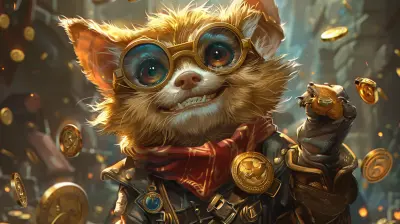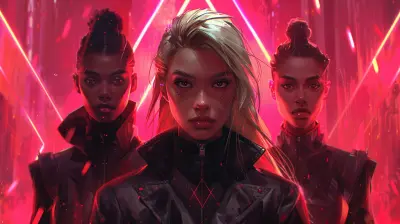Is Your Favorite Game Milking You with Microtransactions?
5 November 2025
Let’s talk about the digital elephant in the room — microtransactions. You know, those tiny purchases in video games that are supposed to be optional but somehow feel like mandatory cover charges at your own birthday party. Whether you’re buying a cool new skin, a random loot box, or just a slightly faster horse (hey, looking at you, Red Dead Online), chances are you’ve whipped out your credit card once or twice for that sweet virtual satisfaction. But… is your favorite game genuinely fun, or is it sneakily draining your wallet like a vampire with a PayPal account?
Grab your energy drink of choice and buckle in, because we’re diving deep into the sometimes-infuriating, sometimes-hilarious world of microtransactions — and why your go-to game might be exploiting your love just a little too enthusiastically.
What Even Are Microtransactions?
Let’s start with the basics. Microtransactions are small in-game purchases that offer players digital goods. Think costumes, power-ups, loot boxes, randomized items, extra levels — basically any content that’s behind a paywall after you’ve installed the game (or even paid for it).Now, in a perfect world, microtransactions would be like toppings on a pizza — strictly optional and only there to enhance your flavor. But in reality, some games are more like “You can have pepperoni… if you pay $5.99 per slice.”
The Freemium Trap: Free to Play, Expensive to Win
So many mobile games and even some console and PC titles lure you in with “It’s free!” banners, like an overenthusiastic club promoter handing out flyers. But once you're hooked? BAM. Suddenly, you’re getting outpaced by that one guy who bought the $89.99 “Ultra Mega Sapphire Unicorn Bundle with Wings.”Ever played a game where the first few levels are smooth sailing — a couple power-ups here, a few shiny victories there — and then, out of nowhere, you hit a wall harder than Wile E. Coyote chasing the Road Runner? Yep, that's where the freemium shark shows its teeth.
These games are designed to frustrate you just enough that you'll start thinking, “Eh, what’s $2.99 for some gems? I deserve it.” Spoiler alert: it’s never just $2.99. It’s the gateway snack to a buffet of digital spending.
Pay to Win vs. Pay for Style
Not all microtransactions are created equal. Unless we’re talking loot boxes… then yeah, most of them come from the same shady alley.There are generally two categories:
1. Pay to Win (PTW)
This is the real villain in the story. PTW games give big spenders a noticeable upper hand — better weapons, faster upgrades, or invincibility potions that make them gods among mere mortals grinding for XP. Multiplayer games are especially guilty of this, turning fair competition into a wallet-measuring contest.2. Cosmetic Purchases
These are the least offensive. We're talking skins, emotes, dances (Fortnite, we see you) that don’t affect gameplay but make your character look lit. Sure, they’re overpriced and possibly feeding your need to be the slickest elf warrior in the lobby, but at least they don't give anyone a competitive edge.Still, when did we all agree that a digital dragon hoodie is worth $19.99?
The Psychology Behind the Swipe
Game developers aren’t just throwing microtransactions willy-nilly and hoping for the best. Nah, they’ve studied human psychology harder than your cousin crammed for their SATs.There’s a reason why your favorite game shows you that shiny “LIMITED TIME OFFER – 12 HOURS LEFT” banner. It’s designed to trigger FOMO (Fear Of Missing Out). “Only 500 of this skin exist!” Oh no! You might not be one of the chosen ones unless you spend five bucks… right now.
Pair that with the fact that many in-game currencies aren't directly tied to real-world money (1000 gems for $9.99, 2700 gems for $24.99 — what kind of math is this?), and you've got a recipe for confusion that leads to overspending.
It’s like going into a coffee shop where they accept beans instead of dollars. You load up, forget what it cost, and leave wondering how your latte ended up at $17.
Subscription Fatigue: The New Kid on the Block
As if microtransactions weren’t enough, now we’ve got battle passes and gaming subscriptions. Don’t get me wrong, some of them are decent deals. But let’s be real — when you’ve got Netflix, Disney+, Spotify, Game Pass, Nintendo Switch Online, AND a Fortnite battle pass, your subscriptions are starting to look more stacked than your actual game library.And some battle passes even reward you with more in-game currency if you play enough. Sounds good in theory, right? But that means the game now has extra motivation to keep you constantly logging in. Miss a week? Say goodbye to that sweet, sweet skin at tier 72.
You’re not playing the game; the game is playing you.
The Whales, the Minnows, and the Rest of Us
In the gaming industry, they use terms like “whales” and “minnows.” Sounds like an aquarium, but nope — it’s how they describe spending habits.- Whales: The big spenders. They drop hundreds (sometimes thousands) of dollars on microtransactions. These players can singlehandedly fund an entire game's budget.
- Minnows: The occasional spenders. Maybe they’ll buy a skin or two, or a battle pass.
- F2P (Free to Play): The rest of us poor souls grinding for that sword upgrade without spending a dime.
The kicker? Many games are actually designed around whales. This is why you’ll often see ridiculous $99.99 “value packs” — they’re not for you, they’re for the select few ready to break open their digital piggy banks.
Games That Went Too Far (and Got Called Out)
Let’s take a stroll down memory lane and look at some iconic examples of over-the-top microtransaction madness.Star Wars Battlefront II (2017)
Ah yes, the game that made the internet explode faster than a Death Star. When it launched, key characters like Darth Vader were locked behind absurd amounts of playtime… or you know, you could pay for them. The backlash was so intense it made actual news headlines, and EA had to do a complete 180.Diablo Immortal
“Do you guys not have phones?” Yes, we do. And we also have credit card limits, okay? Diablo Immortal sparked controversy with its aggressive monetization. Some players calculated it could cost over $100K to fully max out a character. That’s not a game; that’s a mortgage.NBA 2K Series
This series has slowly morphed into a basketball-slash-casino hybrid. Slot machines, microtransaction-heavy MyTeam modes, and overpriced virtual currency (VC) have left many fans feeling like they’ve wandered into a Vegas back alley instead of the court.The Ethical Debate: Are Microtransactions Evil?
Okay, so not all microtransactions are born out of the devil's code. Some developers genuinely need them to keep free games running. Servers aren’t free, and neither are marketing campaigns or voice actors who sound like they just walked off a Hollywood set.But — and it’s a big but — there’s a fine line between making money and manipulating your audience. Especially when a lot of players are younger kids who don’t fully grasp that $0.99 fifty times a month adds up.
It all comes down to transparency and balance. If a game is upfront about costs, keeps the playing field fair, and offers real value, then fine — throw in that cat-eared helmet. But if it’s locking content behind vague paywalls, using manipulative tactics, or relying too much on RNG loot boxes, maybe it’s time to uninstall... or at least hide your wallet.
How to Avoid Getting Milked
Worried your wallet’s been the MVP of your gaming career? Here are some quick tips to avoid getting milked like a digital cow:- Set a Budget: Know how much you’re okay spending per month. If it’s $10, stick to it.
- Avoid Impulse Buys: If that skin is SO limited, sleep on it. If you still want it tomorrow, maybe.
- Understand the Currency: Look up how much those in-game gems/crowns/beans actually cost in real money.
- Beware of Loot Boxes: Gambling laws aside, these things are designed to mess with your brain. Skip the RNG.
- Reward Good Behavior: Support devs who do microtransactions right. Vote with your wallet.
Final Thoughts: Don’t Let Your Game Play You
We get it. Microtransactions are part of the modern gaming landscape. Not all are evil. Some support devs, extend a game's life, and let us customize our toons until they look like futuristic fashion gods. But let’s not pretend every purchase is harmless fun.So next time your favorite game flashes a “LIMITED PREMIUM OFFER” that costs more than your lunch, ask yourself: Am I enjoying this, or am I just paying to feel like I’m keeping up?
Because no matter how legendary that mythical rainbow sword looks — it ain’t worth going broke over.
all images in this post were generated using AI tools
Category:
In Game PurchasesAuthor:

Lana Johnson
Discussion
rate this article
1 comments
Chloe Clarke
This article raises important questions about microtransactions in gaming. While they can enhance experiences, excessive monetization often detracts from gameplay and player enjoyment. It's crucial for developers to find a balance that respects loyal fans without prioritizing profits over quality. Let's advocate for fair practices in our favorite games!
November 6, 2025 at 4:24 AM

Lana Johnson
Thank you for your insightful comment! Balancing monetization and player enjoyment is essential, and advocating for fair practices will benefit both developers and fans alike.


